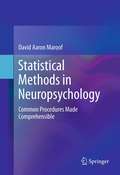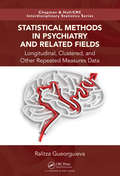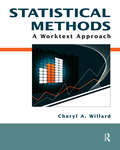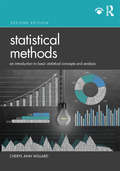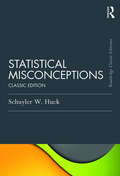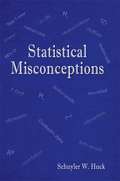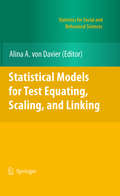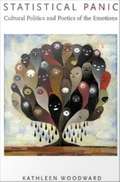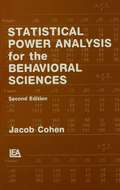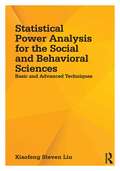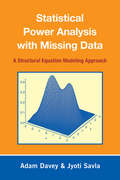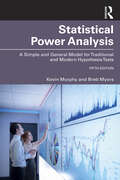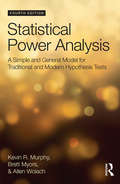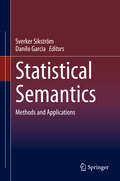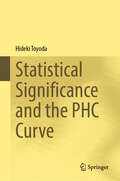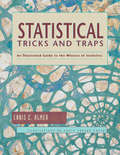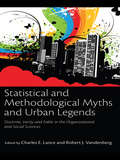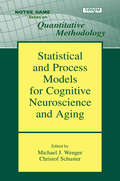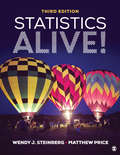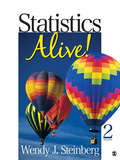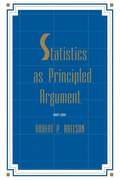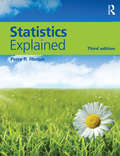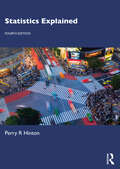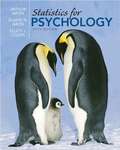- Table View
- List View
Statistical Methods in Neuropsychology
by David Aaron MaroofThis book describes appropriate statistical models that are commonly utilized in neuropsychology. The book discusses such issues as developing normative data for neuropsychological measures, assessing the validity of neuropsychological tests, and quantifying change "over time" through longitudinal analyses. The rationale for and allure of the volume is the fact that there are no publications that dovetail the two subdisciplines of applied statistics and neuropsychology. The overall objective of this book is to provide a pragmatic and concrete source for applying methodological and statistical techniques in research studies whose emphasis includes neuropsychology. Since there are a plethora of technique to arrive at similar answers, each method with its strengths and weaknesses will be delineated. The beauty of the book will be that it will hopefully demystify commonly encountered issues faced with researchers. More specifically, it will provide a "how to do it" approach.
Statistical Methods in Psychiatry and Related Fields: Longitudinal, Clustered, and Other Repeated Measures Data (Chapman & Hall/CRC Interdisciplinary Statistics)
by Ralitza GueorguievaData collected in psychiatry and related fields are complex because outcomes are rarely directly observed, there are multiple correlated repeated measures within individuals, there is natural heterogeneity in treatment responses and in other characteristics in the populations. Simple statistical methods do not work well with such data. More advanced statistical methods capture the data complexity better, but are difficult to apply appropriately and correctly by investigators who do not have advanced training in statistics. This book presents, at a non-technical level, several approaches for the analysis of correlated data: mixed models for continuous and categorical outcomes, nonparametric methods for repeated measures and growth mixture models for heterogeneous trajectories over time. Separate chapters are devoted to techniques for multiple comparison correction, analysis in the presence of missing data, adjustment for covariates, assessment of mediator and moderator effects, study design and sample size considerations. The focus is on the assumptions of each method, applicability and interpretation rather than on technical details. Features Provides an overview of intermediate to advanced statistical methods applied to psychiatry. Takes a non-technical approach with mathematical details kept to a minimum. Includes lots of detailed examples from published studies in psychiatry and related fields. Software programs, data sets and output are available on a supplementary website. The intended audience are applied researchers with minimal knowledge of statistics, although the book could also benefit collaborating statisticians. The book, together with the online materials, is a valuable resource aimed at promoting the use of appropriate statistical methods for the analysis of repeated measures data. Ralitza Gueorguieva is a Senior Research Scientist at the Department of Biostatistics, Yale School of Public Health. She has more than 20 years experience in statistical methodology development and collaborations with psychiatrists and other researchers, and is the author of over 130 peer-reviewed publications.
Statistical Methods: A Worktext Approach
by Cheryl A Willard• Statistical Methods: A Worktext Approach uses a student-friendly, conversational tone to explain core statistical concepts in a way that students can readily understand. • After concepts and skills are introduced and demonstrated, students are given a hands-on opportunity to work with the concepts and practice their newly acquired skills with Your Turn exercises. • Each chapter begins with a careful explanation of the statistical concepts relevant to that chapter. Following the explanation of concepts are examples that illustrate their applications. • Boxes containing helpful pointers for students are included in the chapters. These are often mnemonics for remembering concepts and precautions warning against common mistakes. • Statistical terms are in boldfaced type and italicized. They are defined in the text and also appear in the glossary in Appendix A. • An extensive instructor’s guide provides answers to the exercises.
Statistical Methods: An Introduction to Basic Statistical Concepts and Analysis
by Cheryl Ann WillardStatistical Methods: An Introduction to Basic Statistical Concepts and Analysis, Second Edition is a textbook designed for students with no prior training in statistics. It provides a solid background of the core statistical concepts taught in most introductory statistics textbooks. Mathematical proofs are deemphasized in favor of careful explanations of statistical constructs.The text begins with coverage of descriptive statistics such as measures of central tendency and variability, then moves on to inferential statistics. Transitional chapters on z-scores, probability, and sampling distributions pave the way to understanding the logic of hypothesis testing and the inferential tests that follow. Hypothesis testing is taught through a four-step process. These same four steps are used throughout the text for the other statistical tests presented including t tests, one- and two-way ANOVAs, chi-square, and correlation. A chapter on nonparametric tests is also provided as an alternative when the requirements cannot be met for parametric tests.Because the same logical framework and sequential steps are used throughout the text, a consistency is provided that allows students to gradually master the concepts. Their learning is enhanced further with the inclusion of "thought questions" and practice problems integrated throughout the chapters. New to the second edition: Chapters on factorial analysis of variance and non-parametric techniques for all data Additional and updated chapter exercises for students to test and demonstrate their learning Full instructor resources: test bank questions, Powerpoint slides, and an Instructor Manual
Statistical Misconceptions: Classic Edition (Psychology Press & Routledge Classic Editions)
by Schuyler W. HuckThis engaging book helps readers identify and then discard 52 misconceptions about data and statistical summaries. The focus is on major concepts contained in typical undergraduate and graduate courses in statistics, research methods, or quantitative analysis. Interactive Internet exercises that further promote undoing the misconceptions are found on the book's website. The author’s accessible discussion of each misconception has five parts: The Misconception - a brief description of the misunderstanding Evidence that the Misconception Exists – examples and claimed prevalence Why the Misconception is Dangerous – consequence of having the misunderstanding Undoing the Misconception - how to think correctly about the concept Internet Assignment - an interactive activity to help readers gain a firm grasp of the statistical concept and overcome the misconception. The book's statistical misconceptions are grouped into 12 chapters that match the topics typically taught in introductory/intermediate courses. However, each of the 52 discussions is self-contained, thus allowing the misconceptions to be covered in any order without confusing the reader. Organized and presented in this manner, the book is an ideal supplement for any standard textbook. An ideal supplement for undergraduate and graduate courses in statistics, research methods, or quantitative analysis taught in psychology, education, business, nursing, medicine, and the social sciences. The book also appeals to independent researchers interested in undoing their statistical misconceptions.
Statistical Misconceptions: Classic Edition (Psychology Press And Routledge Classic Editions Ser.)
by Schuyler HuckBrief and inexpensive, this engaging book helps readers identify and then discard 52 misconceptions about data and statistical summaries. The focus is on major concepts contained in typical undergraduate and graduate courses in statistics, research methods, or quantitative analysis. Fun interactive Internet exercises that further promote undoing the misconceptions are found on the book's website. The author’s accessible discussion of each misconception has five parts: The Misconception - a brief description of the misunderstanding Evidence that the Misconception Exists – examples and claimed prevalence Why the Misconception is Dangerous – consequence of having the misunderstanding Undoing the Misconception - how to think correctly about the concept Internet Assignment - an interactive activity to help readers gain a firm grasp of the statistical concept and overcome the misconception. The book's statistical misconceptions are grouped into 12 chapters that match the topics typically taught in introductory/intermediate courses. However, each of the 52 discussions is self-contained, thus allowing the misconceptions to be covered in any order without confusing the reader. Organized and presented in this manner, the book is an ideal supplement for any standard textbook. Statistical Misconceptions is appropriate for courses taught in a variety of disciplines including psychology, medicine, education, nursing, business, and the social sciences. The book also will benefit independent researchers interested in undoing their statistical misconceptions.
Statistical Models for Test Equating, Scaling, and Linking
by Alina A. DavierThe goal of this book is to emphasize the formal statistical features of the practice of equating, linking, and scaling. The book encourages the view and discusses the quality of the equating results from the statistical perspective (new models, robustness, fit, testing hypotheses, statistical monitoring) as opposed to placing the focus on the policy and the implications, which although very important, represent a different side of the equating practice. The book contributes to establishing "equating" as a theoretical field, a view that has not been offered often before. The tradition in the practice of equating has been to present the knowledge and skills needed as a craft, which implies that only with years of experience under the guidance of a knowledgeable practitioner could one acquire the required skills. This book challenges this view by indicating how a good equating framework, a sound understanding of the assumptions that underlie the psychometric models, and the use of statistical tests and statistical process control tools can help the practitioner navigate the difficult decisions in choosing the final equating function. This book provides a valuable reference for several groups: (a) statisticians and psychometricians interested in the theory behind equating methods, in the use of model-based statistical methods for data smoothing, and in the evaluation of the equating results in applied work; (b) practitioners who need to equate tests, including those with these responsibilities in testing companies, state testing agencies, and school districts; and (c) instructors in psychometric, measurement, and psychology programs.
Statistical Panic: Cultural Politics and Poetics of the Emotions
by Kathleen WoodwardIn this moving and thoughtful book, Kathleen Woodward explores the politics and poetics of the emotions, focusing on American culture since the 1960s. She argues that we are constrained in terms of gender, race, and age by our culture's scripts for "emotional" behavior and that the accelerating impoverishment of interiority is a symptom of our increasingly media-saturated culture. She also shows how we can be empowered by stories that express our experience, revealing the value of our emotions as a crucial form of intelligence. Referring discreetly to her own experience, Woodward examines the interpenetration of social structures and subjectivity, considering how psychological emotions are social phenomena, with feminist anger, racial shame, old-age depression, and sympathy for non-human cyborgs (including robots) as key cases in point. She discusses how emerging institutional and discursive structures engender "new" affects that in turn can help us understand our changing world if we are attentive to them--the "statistical panic" produced by the risk society, with its numerical portents of disease and mortality; the rage prompted by impenetrable and bloated bureaucracies; the brutal shame experienced by those caught in the crossfire of the media; and the conservative compassion that is not an emotion at all, only an empty political slogan. The orbit of Statistical Panic is wide, drawing in feminist theory, critical phenomenology, and recent theories of the emotions. But at its heart are stories. As an antidote to the vacuous dramas of media culture, with its mock emotions and scattershot sensations, Woodward turns to the autobiographical narrative. Stories of illness--by Joan Didion, Yvonne Rainer, Paul Monette, and Alice Wexler, among others--receive special attention, with the inexhaustible emotion of grief framing the book as a whole.
Statistical Power Analysis for the Behavioral Sciences
by Jacob CohenStatistical Power Analysis is a nontechnical guide to power analysis in research planning that provides users of applied statistics with the tools they need for more effective analysis. The Second Edition includes: * a chapter covering power analysis in set correlation and multivariate methods; * a chapter considering effect size, psychometric reliability, and the efficacy of "qualifying" dependent variables and; * expanded power and sample size tables for multiple regression/correlation.
Statistical Power Analysis for the Social and Behavioral Sciences: Basic and Advanced Techniques
by Xiaofeng Steven LiuThis is the first book to demonstrate the application of power analysis to the newer more advanced statistical techniques that are increasingly used in the social and behavioral sciences. Both basic and advanced designs are covered. Readers are shown how to apply power analysis to techniques such as hierarchical linear modeling, meta-analysis, and structural equation modeling. Each chapter opens with a review of the statistical procedure and then proceeds to derive the power functions. This is followed by examples that demonstrate how to produce power tables and charts. The book clearly shows how to calculate power by providing open code for every design and procedure in R, SAS, and SPSS. Readers can verify the power computation using the computer programs on the book's website. There is a growing requirement to include power analysis to justify sample sizes in grant proposals. Most chapters are self-standing and can be read in any order without much disruption.This book will help readers do just that. Sample computer code in R, SPSS, and SAS at www.routledge.com/9781848729810 are written to tabulate power values and produce power curves that can be included in a grant proposal. Organized according to various techniques, chapters 1 – 3 introduce the basics of statistical power and sample size issues including the historical origin, hypothesis testing, and the use of statistical power in t tests and confidence intervals. Chapters 4 - 6 cover common statistical procedures -- analysis of variance, linear regression (both simple regression and multiple regression), correlation, analysis of covariance, and multivariate analysis. Chapters 7 - 11 review the new statistical procedures -- multi-level models, meta-analysis, structural equation models, and longitudinal studies. The appendixes contain a tutorial about R and show the statistical theory of power analysis. Intended as a supplement for graduate courses on quantitative methods, multivariate statistics, hierarchical linear modeling (HLM) and/or multilevel modeling and SEM taught in psychology, education, human development, nursing, and social and life sciences, this is the first text on statistical power for advanced procedures. Researchers and practitioners in these fields also appreciate the book‘s unique coverage of the use of statistical power analysis to determine sample size in planning a study. A prerequisite of basic through multivariate statistics is assumed.
Statistical Power Analysis with Missing Data: A Structural Equation Modeling Approach
by Adam Davey Jyoti "Tina" SavlaStatistical power analysis has revolutionized the ways in which we conduct and evaluate research. Similar developments in the statistical analysis of incomplete (missing) data are gaining more widespread applications. This volume brings statistical power and incomplete data together under a common framework, in a way that is readily accessible to those with only an introductory familiarity with structural equation modeling. It answers many practical questions such as: How missing data affects the statistical power in a study How much power is likely with different amounts and types of missing data How to increase the power of a design in the presence of missing data, and How to identify the most powerful design in the presence of missing data. Points of Reflection encourage readers to stop and test their understanding of the material. Try Me sections test one’s ability to apply the material. Troubleshooting Tips help to prevent commonly encountered problems. Exercises reinforce content and Additional Readings provide sources for delving more deeply into selected topics. Numerous examples demonstrate the book’s application to a variety of disciplines. Each issue is accompanied by its potential strengths and shortcomings and examples using a variety of software packages (SAS, SPSS, Stata, LISREL, AMOS, and MPlus). Syntax is provided using a single software program to promote continuity but in each case, parallel syntax using the other packages is presented in appendixes. Routines, data sets, syntax files, and links to student versions of software packages are found at www.psypress.com/davey. The worked examples in Part 2 also provide results from a wider set of estimated models. These tables, and accompanying syntax, can be used to estimate statistical power or required sample size for similar problems under a wide range of conditions. Class-tested at Temple, Virginia Tech, and Miami University of Ohio, this brief text is an ideal supplement for graduate courses in applied statistics, statistics II, intermediate or advanced statistics, experimental design, structural equation modeling, power analysis, and research methods taught in departments of psychology, human development, education, sociology, nursing, social work, gerontology and other social and health sciences. The book’s applied approach will also appeal to researchers in these areas. Sections covering Fundamentals, Applications, and Extensions are designed to take readers from first steps to mastery.
Statistical Power Analysis: A Simple and General Model for Traditional and Modern Hypothesis Tests, Fifth Edition
by Kevin R. Murphy Brett MyorsStatistical Power Analysis explains the key concepts in statistical power analysis and illustrates their application in both tests of traditional null hypotheses (that treatments or interventions have no effect in the population) and in tests of the minimum-effect hypotheses (that the population effects of treatments or interventions are so small that they can be safely treated as unimportant). It provides readers with the tools to understand and perform power analyses for virtually all the statistical methods used in the social and behavioral sciences. Brett Myors and Kevin Murphy apply the latest approaches of power analysis to both null hypothesis and minimum-effect testing using the same basic unified model. This book starts with a review of the key concepts that underly statistical power. It goes on to show how to perform and interpret power analyses, and the ways to use them to diagnose and plan research. We discuss the uses of power analysis in correlation and regression, in the analysis of experimental data, and in multilevel studies. This edition includes new material and new power software. The programs used for power analysis in this book have been re-written in R, a language that is widely used and freely available. The authors include R codes for all programs, and we have also provided a web-based app that allows users who are not comfortable with R to perform a wide range of analyses using any computer or device that provides access to the web. Statistical Power Analysis helps readers design studies, diagnose existing studies, and understand why hypothesis tests come out the way they do. The fifth edition includes updates to all chapters to accommodate the most current scholarship, as well as recalculations of all examples. This book is intended for graduate students and faculty in the behavioral and social sciences; researchers in other fields will find the concepts and methods laid out here valuable and applicable to studies in many domains.
Statistical Power Analysis: A Simple and General Model for Traditional and Modern Hypothesis Tests, Fourth Edition
by Kevin R. Murphy Brett Myors Allen WolachNoted for its accessible approach, this text applies the latest approaches of power analysis to both null hypothesis and minimum-effect testing using the same basic unified model. Through the use of a few simple procedures and examples, the authors show readers with little expertise in statistical analysis how to obtain the values needed to carry out the power analysis for their research. Illustrations of how these analyses work and how they can be used to choose the appropriate criterion for defining statistically significant outcomes are sprinkled throughout. The book presents a simple and general model for statistical power analysis based on the F statistic and reviews how to determine: the sample size needed to achieve desired levels of power; the level of power needed in a study; the size of effect that can be reliably detected by a study; and sensible criteria for statistical significance. The book helps readers design studies, diagnose existing studies, and understand why hypothesis tests come out out the way they do. The fourth edition features: -New Boxed Material sections provide examples of power analysis in action and discuss unique issues that arise as a result of applying power analyses in different designs. -Many more worked examples help readers apply the concepts presented. -Expanded coverage of power analysis for multifactor analysis of variance (ANOVA) to show readers how to analyze up to four factors with repeated measures on any or all of the factors. -Re-designed and expanded web based One Stop F Calculator software and data sets that allow users to perform all of the book's analyses and conduct significance tests, power analyses, and assessments of N and alpha needed for traditional and minimum-effects tests. -Easy to apply formulas for approximating the number of subjects required to reach adequate levels of power in a wide range of studies. Intended as a supplement for graduate/advanced undergraduate courses in research methods or experimental design, intermediate, advanced, or multivariate statistics, statistics II, or psychometrics, taught in psychology, education, business, and other social and health sciences, researchers also appreciate the book‘s applied approach.
Statistical Semantics: Methods and Applications
by Danilo Garcia Sverker SikströmThis book discusses the application of various statistical methods to texts, rather than numbers, in various fields in behavioral science. It proposes an approach where quantitative methods are applied to data whereas previously such data were analyzed only by qualitative research methods. To emphasize the quantitative aspects of semantics, and the possibilities of conducting scientific interferences, the book introduces the concept of statistical semantics and presents the reader with a subset of techniques found in that domain. More specifically, the book focuses on methods that allow the investigation of semantic relationships between words, based on empirical corpus data. It shows the reader how to apply various statistical methods on texts, for example statistical tests to ascertain whether two sets of text are statistically different, ways to predict variables from text, as well as how to summarize and graphically illustrate texts. Thus, the book presents an accessible hands-on introduction to a selection of techniques, indispensable for cognitive psychologists, linguists, and social psychologists.
Statistical Significance and the PHC Curve
by Hideki ToyodaThis book explains the importance of using the probability that the hypothesis is correct (PHC), an intuitive measure that anyone can understand, as an alternative to the p-value. In order to overcome the “reproducibility crisis” caused by the misuse of significance tests, this book provides a detailed explanation of the mechanism of p-hacking using significance tests, and concretely shows the merits of PHC as an alternative to p-values. In March 2019, two impactful papers on statistics were published. One paper, "Moving to a World Beyond ‘p The American Statistician, overseen by the American Statistical Association. The title of the first chapter is “Don't Say ‘Statistically Significant’”, and it uses the imperative form to clearly forbid the use of significance testing. Another paper, “Retire statistical significance”, was published in the prestigious scientific journal Nature. This commentary was endorsed by more than 800 scientists, advocating for the statement, “We agree, and call for the entire concept of statistical significance to be abandoned.” Consider a study comparing the duration of hospital stays between treatments A and B. Previously, research conclusions were typically stated as: “There was a statistically significant difference at the 5% level in the average duration of hospital stays.” This phrasing is quite abstract. Instead, we present the following conclusion as an example: (1) The average duration of hospital stays for Group A is at least half a day shorter than for Group B. (2) 71% of patients in Group A have shorter hospital stays than the average for Group B. (3) Group A has an average hospital stay that is, on average, no more than 94% of that of Group B. Then, the probability that the expression is correct is shown. That is the PHC curve.
Statistical Tricks and Traps: An Illustrated Guide to the Misuses of Statistics
by Ennis C Almer Louie Joseph CantalFirst Published in 2017. Routledge is an imprint of Taylor & Francis, an Informa company.
Statistical and Methodological Myths and Urban Legends: Doctrine, Verity and Fable in Organizational and Social Sciences
by Charles E. LanceThis book provides an up-to-date review of commonly undertaken methodological and statistical practices that are sustained, in part, upon sound rationale and justification and, in part, upon unfounded lore. Some examples of these "methodological urban legends", as we refer to them in this book, are characterized by manuscript critiques such as: (a) "your self-report measures suffer from common method bias"; (b) "your item-to-subject ratios are too low"; (c) "you can’t generalize these findings to the real world"; or (d) "your effect sizes are too low". Historically, there is a kernel of truth to most of these legends, but in many cases that truth has been long forgotten, ignored or embellished beyond recognition. This book examines several such legends. Each chapter is organized to address: (a) what the legend is that "we (almost) all know to be true"; (b) what the "kernel of truth" is to each legend; (c) what the myths are that have developed around this kernel of truth; and (d) what the state of the practice should be. This book meets an important need for the accumulation and integration of these methodological and statistical practices.
Statistical and Process Models for Cognitive Neuroscience and Aging (Notre Dame Series On Quantitative Methodology Ser.)
by Michael J. Wenger Christof SchusterStatistical and Process Models for Cognitive Neuroscience and Aging addresses methodological techniques for researching cognitive impairment, Alzheimer's disease, the biophysics and structure of the nervous system, the physiology of memory, and the analysis of EEG data. Each chapter, written by the expert in the area, provides a carefully crafted i
Statistics Alive!
by Matthew Price Wendy J. SteinbergStatistics need not be dull and dry! Statistics Alive! by Wendy J. Steinberg and new coauthor Matthew Price presents essential content on statistical analysis in short, digestible modules. Written in a conversational tone with anecdotal stories and light-hearted humor, this text is an enjoyable read. Students are shown the underlying logic to what they're learning, and well-crafted practice and self-check features help ensure that that new knowledge sticks. Coverage of probability theory and mathematical proofs is complemented by expanded conceptual coverage. The Third Edition includes simplified practice problems and increased coverage of conceptual statistics, integrated discussions of effect size with hypothesis testing, and new coverage of ethical practices for conducting research.
Statistics Alive!
by Matthew Price Wendy J. SteinbergStatistics need not be dull and dry! Statistics Alive! by Wendy J. Steinberg and new coauthor Matthew Price presents essential content on statistical analysis in short, digestible modules. Written in a conversational tone with anecdotal stories and light-hearted humor, this text is an enjoyable read. Students are shown the underlying logic to what they're learning, and well-crafted practice and self-check features help ensure that that new knowledge sticks. Coverage of probability theory and mathematical proofs is complemented by expanded conceptual coverage. The Third Edition includes simplified practice problems and increased coverage of conceptual statistics, integrated discussions of effect size with hypothesis testing, and new coverage of ethical practices for conducting research.
Statistics Alive! (2nd Edition)
by Wendy J. SteinbergBased on years of first-hand teaching experience, Wendy J. Steinberg has created Statistics Alive!, the most user-friendly statistics text for students in the social and behavioral sciences, now in its Second Edition. This textbook includes topics such as frequency distributions, hypothesis formation, and inferential statistics and bivariate regression. Effect size and power, often shortchanged in other textbooks, each get substantive treatment. Students are well prepared for a next course in statistics.Key Features Modular treatment allows students to master prescribed chunks of information. Strong pedagogy throughout includes learning objectives, key terms, and "Check Yourself!" questions. New to the Second Edition Twice as many chapter exercises.Final module on multiple regression and the General Linear Model. SPSS point-and-click instructions and screen shots of the output for all in-text examples.Descriptive dispersion solutions shown using both N and n-1 denominators, to accommodate any instructor's preference. A more comprehensive Student Study Guide and Instructor Resource Guide.
Statistics As Principled Argument
by Robert P. AbelsonIn this illuminating volume, Robert P. Abelson delves into the too-often dismissed problems of interpreting quantitative data and then presenting them in the context of a coherent story about one's research. Unlike too many books on statistics, this is a remarkably engaging read, filled with fascinating real-life (and real-research) examples rather than with recipes for analysis. It will be of true interest and lasting value to beginning graduate students and seasoned researchers alike. The focus of the book is that the purpose of statistics is to organize a useful argument from quantitative evidence, using a form of principled rhetoric. Five criteria, described by the acronym MAGIC (magnitude, articulation, generality, interestingness, and credibility) are proposed as crucial features of a persuasive, principled argument. Particular statistical methods are discussed, with minimum use of formulas and heavy data sets. The ideas throughout the book revolve around elementary probability theory, t tests, and simple issues of research design. It is therefore assumed that the reader has already had some access to elementary statistics. Many examples are included to explain the connection of statistics to substantive claims about real phenomena.
Statistics Explained
by Perry R. HintonStatistics Explained is an accessible introduction to statistical concepts and ideas. It makes few assumptions about the reader’s statistical knowledge, carefully explaining each step of the analysis and the logic behind it. The book: provides a clear explanation of statistical analysis and the key statistical tests employed in analysing research data gives accessible explanations of how and why statistical tests are used includes a wide range of practical, easy-to-understand worked examples. Building on the international success of earlier editions, this fully updated revision includes developments in statistical analysis, with new sections explaining concepts such as bootstrapping and structural equation modelling. A new chapter - ‘Samples and Statistical Inference’ - explains how data can be analysed in detail to examine its suitability for certain statistical tests. The friendly and straightforward style of the text makes it accessible to all those new to statistics, as well as more experienced students requiring a concise guide. It is suitable for students and new researchers in disciplines including Psychology, Education, Sociology, Sports Science, Nursing, Communication, and Media and Business Studies. Presented in full colour and with an updated, reader-friendly layout, this new edition also comes with a companion website featuring supplementary resources for students. Unobtrusive cross-referencing makes it the ideal companion to Perry R. Hinton’s SPSS Explained, also published by Routledge. Perry R. Hinton has many years of experience in teaching statistics to students from a wide range of disciplines and his understanding of the problems students face forms the basis of this book.
Statistics Explained
by Perry R. HintonStatistics Explained, now in its fully revised Fourth Edition, is for students and researchers who wish to understand the statistical analyses used to analyse quantitative (numerical) research data in a wide range of academic disciplines, in particular, the behavioural, human and social sciences.This book explains, in a clear and informative manner, the logic of statistical analysis, in particular the null hypothesis significance testing (NHST) method. Using this method, a range of statistical tests have been devised for different types of data. Each of these tests is explained in the book by adopting a step-by-step (“walkthrough”) approach with a specific illustrative example. Crucially, these explanations do not require the reader to have an advanced knowledge of mathematics or statistics, but only assumes the basic mathematics which most readers will have learnt at high school. The book also examines the criticisms of NHST and introduces the reader to Bayesian statistics. As a result the reader will be able to critically evaluate the outcomes of statistical analysis both of their own work and that of others.Statistics Explains will be of great interest to students and researchers in the behavioural, human and social sciences in understanding both the outcomes of their own research and also the research reports in the academic journals.
Statistics For Psychology
by Elaine Aron Arthur Aron Elliot CoupsThis author team is committed to making statistics a highlight for psychology students! Now, in a 5th edition, Statistics for Psychology, continues to be an accessible, current, and interesting approach to statistics. With each revision, the authors have maintain those things about the book that have been especially appreciated, while reworking the text to take into account the feedback, their our own experiences, and advances and changes in the field. The fifth edition of this popular text uses definitional formulas to emphasize concepts of statistics, rather than rote memorization. This approach constantly reminds students of the logic behind what they are learning, and each procedure is taught both verbally and numerically, which helps to emphasize the concepts. Thoroughly revised, with new content and many new practice examples, this text takes the reader from basic procedures through analysis of variance (ANOVA). While learning statistics, students also learn how to read and interpret current research.
